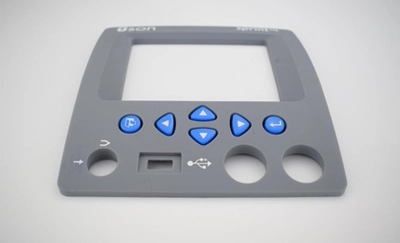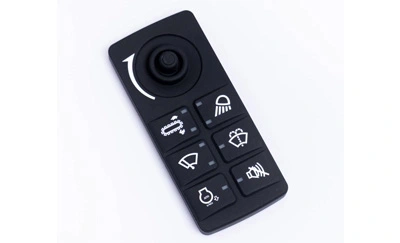Everything About Membrane layer Switch: A Comprehensive Guide for Beginners
Membrane layer switches are important parts in modern-day electronic devices, providing a distinct interface for customer interaction - membrane switch. Their layered construction, consisting of overlays and conductive traces, provides functionality and toughness. Unlike conventional mechanical buttons, membrane layer buttons provide a streamlined design and personalized choices. Understanding their crucial features and benefits can transform product layout. The details of their application and layout considerations call for additional exploration.
What Is a Membrane Switch over?
A membrane layer button is a kind of electrical switch that is composed of a versatile membrane layer layered over a published circuit board. This design enables a smooth and small interface, commonly made use of in numerous digital gadgets. Membrane layer buttons are generally located in consumer devices, clinical devices, and industrial machinery because of their toughness and resistance to ecological factors.The building and construction normally consists of numerous layers, such as visuals overlays and adhesive backing, which offer tactile feedback and safeguard the wiring beneath. The procedure of a membrane button is started when stress is related to the surface, finishing an electrical circuit.These buttons are valued for their convenience, making it possible for custom styles and printed graphics that accommodate certain interface. Their low-profile nature reduces room needs, making them optimal for applications where conventional switches might not fit. Generally, membrane switches use a practical and aesthetic solution for modern-day electronic gadgets.
Key Elements of Membrane Switches Over
Membrane changes consist of several key parts that add to their functionality and efficiency. The top layer, recognized as the overlay, provides the individual interface and is commonly printed with signs or graphics. Beneath the overlay lies a spacer layer, which divides the conductive aspects and prevents unintended activation. The following important element is the graphic layer, which improves aesthetic appeals and ensures the resilience of the design.Conductive traces, normally made from materials like silver or carbon, are published on the circuit layer. When pressure is used to the overlay, these traces enter into get in touch with, finishing the circuit. In addition, a backing layer uses architectural support and can be made from materials such as polyester or polycarbonate. With each other, these components create a reliable, straightforward interface ideal for different applications, from house devices to industrial equipment. Recognizing these components is important for any individual thinking about membrane button innovation.
How Membrane Layer Switches Over Job
Understanding just how membrane layer switches over feature is vital for valuing their prevalent usage in numerous gadgets. A membrane layer button runs with a series of layers, including a graphic overlay, spacer, and a circuit layer. When pressure is applied to the overlay, it compresses the spacer layer, permitting the circuit layer to make call and finish an electrical circuit. This activity sends a signal to the gadget, triggering a feedback, such as activating a light or activating a function.Membrane switches can be made with different attributes, including tactile feedback, backlighting, and customized graphics, improving individual interaction. Their construction enables a closed design, shielding the inner components from dust, moisture, and pollutants. This sturdiness makes them suitable for varied applications, from customer electronics to industrial tools. Generally, the simplicity and performance of membrane layer switches over contribute to their appeal in contemporary technology.
Benefits of Membrane Switches Over Over Mechanical Switches
While mechanical buttons have long been a staple in many devices, membrane layer switches over offer unique advantages that make them increasingly appealing. One substantial benefit is their slim account, enabling more small layouts and greater adaptability in product growth. Additionally, membrane switches function a consistent surface, which improves aesthetic charm and streamlines cleaning, making them suitable for settings where hygiene is critical.Another advantage is their resistance to dirt and wetness. Unlike mechanical buttons, which can be compromised by environmental variables, membrane buttons supply a closed interface that shields against contaminants - membrane switch. In addition, membrane switches generally have a longer life-span due to fewer relocating parts, leading to improved durability and reliability.Cost-effectiveness is additionally a significant advantage, as membrane layer buttons can be created wholesale with reduced production prices. These factors integrate to position membrane switches as a functional option to typical mechanical alternatives in different applications
Usual Applications of Membrane Layer Changes
Membrane buttons are extensively utilized in different industries, especially in customer electronic devices and industrial control panels. In consumer devices, they give a smooth, user-friendly interface, while in commercial setups, they improve resilience and capability. Recognizing these applications highlights the versatility and usefulness of membrane layer switches in modern-day innovation.
Consumer Electronic Devices Gadgets
As customer electronics proceed to progress, membrane switches have actually ended up being a popular selection for a selection of tools because of their versatility and smooth layout. These buttons are generally found in smart devices, tablet computers, and remote controls, where area is minimal and aesthetics issue. Their low account and customizable designs permit producers to develop user-friendly user interfaces that boost the general customer experience. Additionally, membrane switches are typically used in devices such as microwaves and coffee manufacturers, providing user-friendly control choices while resisting wetness visit this web-site and dust. The resilience and dependability of membrane layer changes make them ideal for everyday consumer items, making sure long life and regular performance. In general, their integration in customer electronic devices mirrors a mix of capability and contemporary layout.
Industrial Control Panels
The applications of membrane layer switches extend beyond consumer electronics, discovering considerable usage in commercial control board. These switches are preferred for their sturdiness and resistance to rough settings, making them ideal for making and procedure control setups. They give a reliable interface for drivers to manage machinery, screen procedures, and readjust setups. Membrane switches can be personalized to suit certain operational demands, integrating functions like backlighting and responsive comments, enhancing customer experience. Their low-profile style enables combination into numerous equipment, while their capability to endure spills, dirt, and severe temperature levels warranties long life. In general, membrane layer switches add to secure and efficient procedure in commercial applications, demonstrating their versatility and effectiveness sought after environments.
Considerations for Creating Membrane Switches Over
When creating membrane layer buttons, picking the best products is vital to guarantee resilience and capability. Additionally, comprehending layer arrangement methods can greatly impact the switch's performance and user experience. These factors to consider play a crucial function in my blog developing reliable and reliable membrane switch styles.
Material Choice Value
Product selection plays a crucial function in the layout and functionality of membrane layer buttons. The selected materials straight influence the button's longevity, responsive feedback, and you can check here general visual. Secret factors to consider consist of the substratum, which need to offer architectural honesty while permitting for versatility, and the graphic overlay, which needs to be resistant to wear and ecological factors. Conductive materials should guarantee trustworthy electrical performance, while adhesives have to offer strong bonding without endangering the button's procedure. Additionally, compatibility with making procedures and end-user atmospheres is important; products must endure differing temperatures, moisture levels, and chemical direct exposure. Eventually, ideal product choice not only enhances the membrane layer button's performance but also adds to its long life and individual fulfillment, making it a crucial facet of the layout process.

Layer Setup Methods

Frequently Asked Questions
Exactly How Long Do Membrane Layer Changes Generally Last?
Membrane layer switches typically have a life expectancy of 1 to 5 million cycles, relying on use and environmental problems. Elements such as style quality and operating regularity considerably affect their longevity and total performance long life.

Can Membrane Layer Switches Be Custom-made for Certain Designs?
Membrane layer switches can undoubtedly be customized to accommodate details styles, enabling for diverse forms, colors, and capabilities. This adaptability makes it possible for suppliers to customize these switches to fulfill distinct visual and functional demands successfully.
What Products Are Used in Membrane Layer Switch Building And Construction?
Membrane switches are generally built using products such as polyester, polycarbonate, and adhesive layers. These materials give resistance, flexibility, and toughness to environmental aspects, guaranteeing the switches function properly in numerous applications and problems.
Are Membrane Layer Switches Over Resistant or water-proof to Moisture?
Membrane switches can be made to be moisture-resistant, making use of specialized coverings and products. However, their water resistant abilities depend on building and construction quality and particular applications, making it important to analyze needs for ideal performance in different settings.
Just How Are Membrane Changes Repaired if Damaged?
Fixing broken membrane changes usually involves changing the impacted layer or circuit. Specialists may likewise use conductive sticky or make use of specialized fixing sets, making certain functionality is recovered without full replacement of the entire switch assembly. Unlike standard mechanical switches, membrane switches provide a streamlined style and adjustable choices. A membrane button is a kind of electric switch that consists of a flexible membrane layered over a published circuit board. The procedure of a membrane button is launched when pressure is used to the surface, finishing an electric circuit.These switches are valued for their flexibility, allowing personalized layouts and published graphics that cater to specific individual interfaces. While mechanical buttons have actually long been a staple in numerous devices, membrane layer switches offer distinctive benefits that make them progressively appealing. Membrane buttons normally have a longer lifespan due to fewer moving parts, resulting in boosted sturdiness and reliability.Cost-effectiveness is also a remarkable advantage, as membrane layer buttons can be generated in bulk with lower manufacturing prices.